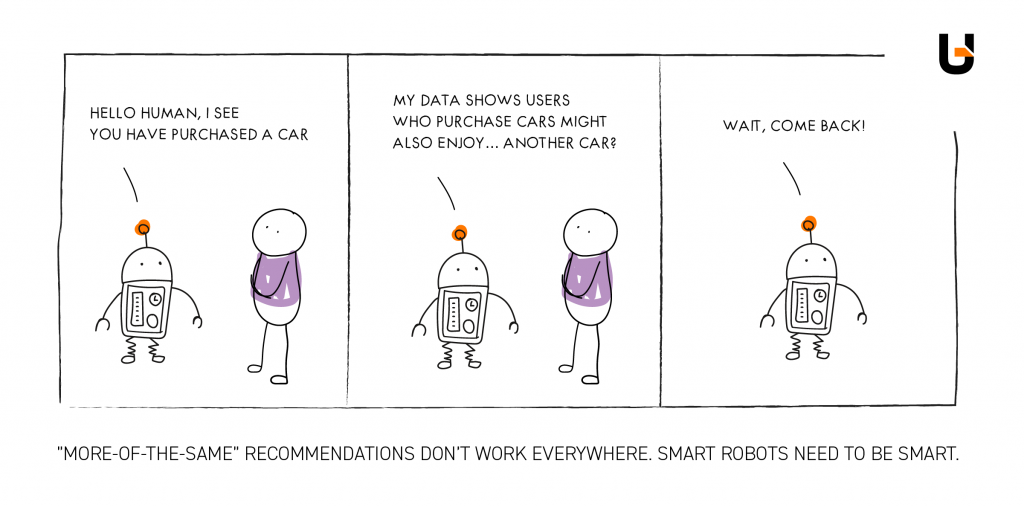Experience-Driven Commerce via Personalization / An Introduction
Experience is everything these days. At least it might seem so between hyperpersonalization, customer experience and a hundred other buzzwords ending in experience (more on that later 😉 )
Specifically in e-commerce & retail, this is an increasingly obvious direction, so we have one encompassing term: experience-driven commerce. Well, one other all encompassing term.
What is Experience-Driven Commerce?
Experience-Driven Commerce is the prioritization of consistent, personalized experiences to shoppers throughout the entire customer journey – across any and all channels in the process – to maximize potential sales and customer loyalty.
Note that this also applies to offline retail just as much as online. Experience-Driven Commerce is from the “just commerce” family of thought. Both online and offline experiences should be consistent and permeate each other.
Why Experience-Driven Commerce Matters
To the surprise of nobody, e-commerce has become an indispensable part of global retailing. In 2020, more than two billion people bought products or services online and, thanks to increasing digitization all over the world, this is readily expected to continue rising. The value of retail sales worldwide in the same year exceeded $4.2 trillion, with both customers and stores increasing in volume.
And that leads to one inevitable outcome: competition.
When offers can only go so low, companies look to other benefits so, as the name implies, customer experience is more vital than ever.
The State of Personalization in E-Commerce
Most companies understand the basics of personalization in e-commerce – but that’s old news. Where the competitive advantage lies, however, is in the next few steps. With almost 91% of consumers willing to make purchases in stores that provide offers and recommendations tailored to their needs, personalization isn’t just confined to the digital channels, either.
Customers expect not only positive experiences at every stage, but also highly personalized ones. At every step of the customer journey, they want to feel like they’re being served by the most dedicated salesperson who knows their needs, capabilities, and even their dreams – often before they realize that’s what they want. There’s a reason companies give discounts to frequent shoppers – they want regulars to feel valued and prioritized.
In the brick-and-mortar world, a great on-site salesperson can do this for you, but what about selling online? The basics of e-commerce personalization are already well known, but is it enough? With 89% of digital commerce companies continuing to invest in personalization, there’s a strong onus to move from “basic” to “advanced”.
Key Factors Behind Personalization in E-Commerce
Since most companies already rely on personalization for their experience-driven commerce, how can you do it well? Specifically, well enough to stand out?
In the face of so much competition, the simplest methods of recommendations, which are one of the foundations for personalization in e-commerce, may turn out to be insufficient. Companies need to reach for more complex solutions. In this case, for example, we can suggest recommendation engines powered through machine learning.

But for all of that, there’s another fundamental truth: if you want to personalize the customer journey of all your customers effectively, you need the appropriate tools that will allow you to gather precise data about their shopping habits. This, in turn, will enable you to create offers and recommendations based on that specific data. From a technology point of view, the answer lies in a combination of e-commerce platforms, access to machine learning and cloud platforms/solutions able to power and support them.
Optimized Experiences (on Optimized Channels)
Modern consumers want access to multiple sales channels. More than just new devices, that includes your brick-and-mortar stores.
Customers don’t differentiate; it’s all one brand, so it’s all one experience.
This is why we recommend the multiexperience approach over a simple omnichannel model. Every aspect should be at its best. Shoppers will choose their own path through those channels, so you can’t simply put all your eggs on the supposedly lucrative last attribution* basket 😉
*fun fact: you can use this exact phrase to make your marketing team shudder in fear
Customer-Centric
Experience-driven commerce needs to put the customer first. And probably second, too! If you don’t provide a satisfactory customer journey, the customer can easily shop elsewhere.
With loyalty hard to come by, you need to focus and prioritize every stage of the customer journey, including after the purchase process is complete. Difficulties with returns or complaints can quickly ruin even the best shopping experience. Speaking of which…
A Total Experience
At the start, we said that Experience-Driven Commerce is one of two buzzwords, so let’s talk about the other.
The customer experience is of course impacted by other factors. An employee that has poor tools for handling returns impacts the customer service… which impacts the customer. The logic is pretty straight forward.
The Total Experience approach (yes, we’re going to get buzzword-heavy… this is a very experience-driven message 😉) encompasses the experience of the entire organization and combines them to provide the best possible experience.
But on the not-so-buzzwordy side, total experience organizations are expected to score 25% better than their competitors on customer experience and employee experience satisfaction metrics by 2024, which isn’t that far away! Identifying problems – even the ones that only indirectly impact the customer – that may occur in different areas will ultimately allow you to solve them and thus stand out from the competition.
For all intents and purposes, experience-driven commerce and total experience come to the same conclusions. The employee experience directly impacts the customer experience, so it’s important to look after everything, including the backend operations.
But there is arguably one key difference…
Real-Time Adaptability
While total experience talks about the grand vision, personalization focuses on the here and now.
The ability to instantly deliver personalized content to each individual user makes their interaction with a brand more personal. This is one of the ways to build a relationship between the customer and the company. The experience is similar to shopping in a stationary store, where the consumer is advised by a trusted salesperson. After all, everyone likes to feel special 😊 Content generated in real time, based on specific customer behaviors, supports the customer journey and drives towards the mail goal – the purchase.
Real-time data tracking is provided by personalization platforms powered by Artificial Intelligence and Machine Learning. Since these are becoming more common place, companies have greater access to automated tools to adapt to changes in the individual shopper’s preference, location, product choices and more.
The Building Blocks of Experience-Driven Commerce
What elements are the basics if you want to build your e-commerce around customer experience and personalization? You need to have data to analyze, check which of your actions are working, and have technology that doesn’t hold back growth.
Data-Heavy
Data collection is at the heart of personalizing every stage of the customer journey, from product discovery, to purchase and… back for more purchases. It’s important to understand what data you’re tracking, who it’s coming from, when you’re tracking it (usually in real time), and with what tools.
It is also important to constantly improve e-commerce functionality, regularly update the website, add new elements, take care of the UX – in other words, constantly work on the best possible customer experience.
If you already have the infrastructure in place to collect data efficiently and accurately, the next step is to plan and execute a personalization strategy. Remember that customers are willing to share data with brands they consider trustworthy. And if you’re not currently collecting such data, remember that a little incentivization goes a long way. You don’t need an app to buy coffee, but there’s a reason you download and log in 😉
A/B Testing
Personalization is, at its very simplest, a form of testing. We’re trying to find what makes an individual unique – in other words, different from the wider “control group” – and testing hypothesis to gain an advantage.
With experience-driven commerce, we want to be as personal as possible, which means getting as niche and specific with our segmentation as possible. As such, we’re looking to move past the most basic data, such as age and gender, and move to the specifics: location, previous purchasing history, behavioral indicators. After all, targeting everyone who is between 40-50 years old isn’t strictly “personalization” more than it is “broad profiling”.
For the most accurate testing, we need to look at multivariate models, testing smaller hypothesis at once, to gain more incremental insights faster.

Of course, segmentation is a good way to start the personalization journey. By testing different groups to identify their needs and different response rates, you start generating more insights with which to delve deeper.
Headless Modularity
To personalize experiences, you need an architecture model that’s open to change. This is an essential no-brainer for fully exploiting the potential experience-driven commerce.
As such, we highly recommend a headless commerce approach, with as many systems or microservices as needed. This allows for changes much more easily, especially when compared to monoliths and their typical “one size fits all” approach to customer experience.
How To Get Started with Experience-Driven Commerce
If you’re not already providing personalized experiences to your customers, you’re falling behind. And even then, if you’re not investing in experience-driven commerce, you’re at risk of falling behind to the leaders that are.
Of course, every business has to start somewhere:
- You absolutely should have the basic forms of personalization, from recommendation engines to simply adapting to different regions.
- However, to get more advanced, you absolutely need to start breaking up the monolith. Modular flexibility is essential for easy on-the-fly changes at an individual user level.
- You also need to ensure you have effective, valid and legal means of collecting the necessary data. This may mean incentivizing the users to give it to you. It’s also good at this point to focus on the customers you already have to built a reliable set of testing data.
- Then, with the data and flexible architecture in hand, you can begin the process of testing, assessing and testing again. Ad infinitum.
We won’t lie – experience-driven commerce does require some significant investment and the further behind you are, the more it takes. However, since we live in an age where the typical e-commerce is no longer “just a website”, this is an inevitable truth the laggards will have to face anyway.









